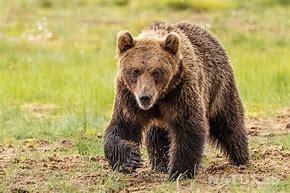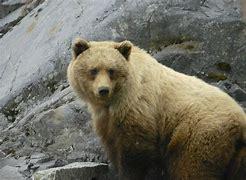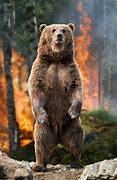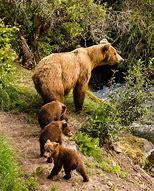Results: The Bear Necessities; the last part, Brown Bears
Published on 06/29/2022
The brown bear (Ursus arctos) is a large bear with the widest distribution of any bear species. They are found in the forests and mountains of northern North America, Europe, and Asia. The brown bear’s principal range includes parts of Russia, Central Asia, China, Canada, the United States (mostly Alaska), Scandinavia and the Carpathian region (especially Romania), Anatolia, and Caucasus. https://justfunfacts.com/interesting-facts-about-brown-bears/ is the source for this survey

QUESTIONS
GO to COMMENTS
Comments
1.
1.
Which of these brown bear facts are you familiar with?

Brown bears can be found in many habitats, from the fringes of deserts to high mountain forests and ice fields. In Europe, the brown bear is mostly found in mountain woodlands, in Siberia it occurs primarily in forests while in North America they prefer tundra, alpine meadows and coastlines. The species' main requirements are areas with dense cover in which they can shelter by day. There are 16 subspecies of brown bears including grizzly bears and Kodiak bears.
23%
473 votes
The brown bear is a naturally long-lived animal. The average lifespan in the wild is about 25 years. The oldest wild brown bear on record was nearly 37 years old. The oldest brown bear in captivity have been verified to live up to 47 years, with one captive male possibly attaining 50 years of age.
16%
334 votes
The brown bear is one of the two largest terrestrial carnivorans alive today, rivaled in body size only by its close cousin, the polar bear (Ursus maritimus), which is much less variable in size and averages larger due to this.
18%
380 votes
The normal range of physical dimensions for a brown bear is a head-and-body length of 1.4 to 2.8 m (4 ft 7 in to 9 ft 2 in) and a shoulder height of 70 to 153 cm (2 ft 4 in to 5 ft 0 in). Adults have massive, heavily built concave skulls, which are large in proportion to the body.
8%
163 votes
None
55%
1147 votes
All of the above
13%
275 votes
2.
2.
Which of these brown bear traits do you know?

The average weight of adult male bears from 19 populations, from around the world and various subspecies (including both large and small bodied subspecies), was found to 217 kg (478 lbs) while adult females from 24 populations were found to average 152 kg (335 lbs). The largest subspecies are the Kodiak bear, which commonly reaches sizes of 300 to 600 kg (660 to 1,320 lbs) and has even been known to exceed weights of 680 kg (1,500 lbs) on occasion.
11%
223 votes
Brown bears are often not fully brown. Brown bears have long, thick fur, with a moderately long mane at the back of the neck which varies somewhat across the races. In India, brown bears can be reddish with silver tips, while in China, brown bears are bicolored with a yellow-brown or whitish cape across the neck, chest, and shoulders. North American grizzlies can be dark brown (almost black) to cream (almost white) or yellowish brown and often have darker colored legs.
18%
384 votes
Due to their claw structure, in addition to their excessive weight, adult brown bears cannot typically climb trees as can both species of black bear, although in rare cases adult female brown bears have been seen in trees. The home range of a brown bear is extremely large, reaching up to 2,000 square kilometers (770 square miles) in males, however they are not highly territorial.
11%
222 votes
Despite their enormous size, brown bears are extremely fast, having been clocked at speeds of 50 kilometers (30 miles) per hour. The brown bear is often described as nocturnal. However, it frequently seems to peak in activity in the morning and early evening hours.
17%
354 votes
None
56%
1182 votes
All of the above
11%
239 votes
3.
3.
Which of these brown bear facts have you heard about?

Brown bears tend to be solitary animals, except for females and their cubs; although they may gather in large numbers at major food sources (e.g., moth colonies, open garbage dumps or rivers holding spawning salmon).
19%
401 votes
Brown bears are omnivorous. Most brown bears are not highly carnivorous, as they derive up to 90% of their dietary food energy from vegetable matter. Their diet varies with the season – from grass and shoots in the spring to berries and apples in the summer, nuts and plums in autumn. All year round they eat roots, insects, mammals, fish, reptiles, and of course, honey.
24%
504 votes
In the Kamchatka peninsula and several parts of coastal Alaska, including Kodiak Island, brown bears feed largely on spawning salmon, whose nutrition and abundance explain the enormous size of the bears in these areas. In fall a brown bear may eat as much as 40 kilograms (90 pounds) of food each day, and it may weigh twice as much before hibernation as it will in spring.
14%
292 votes
None
54%
1137 votes
All of the above
12%
260 votes
4.
4.
Which of these brown bear characteristics are you aware of?

Brown bears hibernate throughout winter, preserving energy by reducing heart rate and body temperature by a few degrees. Hibernation takes place in a den, often dug into a sheltered slope, in which the bear may survive for over half a year without eating, drinking, urinating or defecating.
30%
628 votes
Brown bears mate from May to July, and a gestation of 180 to 266 days follows, with births occurring from January to March, usually while the female is still in hibernation. She generally lays down two to three offspring, and breeds again 2 to 4 years later.
12%
257 votes
Young born bears are vulnerable, being blind, naked and weighing only 350 to 510 g (0.77 to 1.12 lb). They feed on their mother's milk until spring or even early summer, depending on climate conditions. Cubs remain with their mother for some two and a half years.
14%
302 votes
While the brown bear's range has shrunk and it has faced local extinctions, it remains listed as a least concern species by the International Union for Conservation of Nature (IUCN). There are approximately 200,000 brown bears left in the world. The largest populations are in Russia with 120,000, the United States with 32,500, and Canada with around 25,000.
7%
148 votes
None
50%
1054 votes
All of the above
12%
247 votes
COMMENTS


